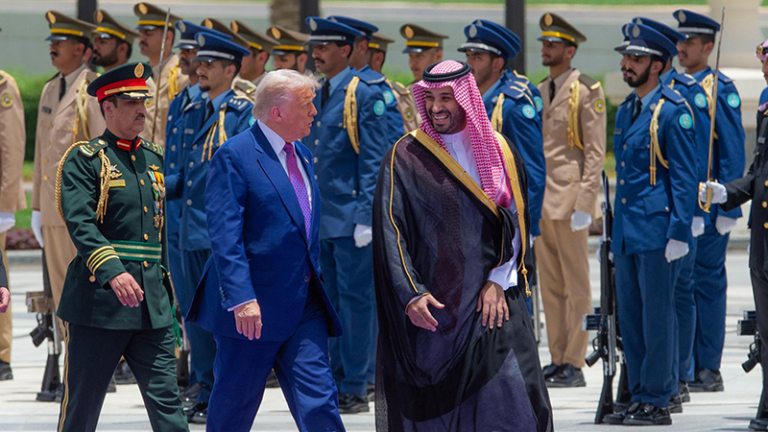
The lasting effects of US President Donald Trump’s visit to the Gulf region may only become clear in the year ahead, making any suggestions of profound changes in US Middle East policy mere guesswork for now. This includes the status of US-Israel relations, Washington’s precise policy on Palestine and the Israeli genocide it enables there, relations with Iran, and trends in US relations with wealthy Arab states in the Gulf. Trump’s visit, however, has revealed a change in the style and substance of US diplomacy under his direction, reflecting his personal whims. What the visit ignored was the calamitous condition of Arab societies outside the energy-producing Gulf states, and indicated that US relations with the latter are by far the most important issue in American policy in the Middle East.
The uncertainty about the ultimate direction of Trump’s policy toward Middle Eastern friends and foes originates in the American president’s approach that is anchored in entertainment values, which focus on garnering attention between now and the next commercial break. It also reflects the reality of the new instability in the US approach to the world.
Instead of Entertainment, Deal with Prevailing Conditions
The mediagenic, captivating images of Trump’s four days in Saudi Arabia, Qatar, and the United Arab Emirates (UAE)—where he signed contracts worth hundreds of billions of dollars with robed men in glittering palaces dancing with swords and riding white horses—offered media entertainment, at least for his supporters. More important, at least for the region, is to assess whether the gala presidential visit will have any impact on the prevailing Middle East dynamics that create the problems that make the region a cause for concern.
It’s important to assess whether Trump’s visit will have any impact on the prevailing Middle East dynamics.
So, this is a moment to do three related things, instead of repeating the same failed policies and perceptions decade after decade, regardless of who rules in the United States or the Middle East. The first is to acknowledge the main factors that have shaped, and indeed ravaged, the Middle East during the past century: continuous foreign imperial and colonial interference and military interventions; authoritarian governance in all Arab states; and the devastating military and economic effects of Zionism and Israel’s assertion of its primacy over Palestinians and Arabs.
The second step is to recognize how these trends since 1920—following the First World War and the defeat of the Arab dream of independence—generated so much marginalization and humiliation among citizens of the Arab world. Along with poor education, unemployment and under employment, water and electricity shortages, and other failures of governance, these trends subsequently drove political violence. They also helped cause mass emigration of youth, severe socioeconomic disparities, environmental deterioration, widespread poverty, and armed conflicts.
The third step should be to assess Trump’s visit not by the contracts that he signed, but by whether whatever policies he pursues, if they are sustained, will exacerbate or dampen these negative trends.
The most recent report by the United Nations Economic and Social Commission for West Asia captures the scale of human distress throughout most Arab lands. It shows that 187 million of the 425 million people living in Arab countries experience deprivation in social protection, healthcare, education, economic empowerment, technology, food security, housing, and basic rights. Two hundred and ninety-two million lack at least one social protection benefit, and 174 million lack access to essential health services. Inequalities and deprivation affect education systems, water and sanitation access, and work opportunities that see informal labor account for 65 percent or more of all workers in the low- and middle-income (i.e., non-oil producing) Arab economies.
Numerous other studies show that more than 40 percent of Arab families cannot save money after buying their necessities while 28 percent reported that they are in “a state of need” with household income not covering their necessary expenditures. Across the region, beyond the lavish Gulf palaces that Trump visited, conditions for the majority of Arabs are difficult or dire, and prospects for their children’s futures look grim.
Proper Assessment
Some aspects of US foreign policy are more apparent after the trip. In substance, Trump and his hosts affirmed that material gains define the bottom line of foreign relations for them. Issues of justice, stopping genocide, or upholding the rule of law can be ignored or postponed for the time being, perhaps forever. This triumph of the material and the profitable over the just and the righteous has always been part of Western imperial behavior in the global South, and helped the region plunge into its current dilapidated state.
In the style department, personal diplomacy and egos now seem more important in shaping state behavior in the Trump age, while established policies can be overturned on a dime if more tangible material benefits beckon. Time will tell if Trump and his wealthy Arab business partners are correct that economic growth can promote a peaceful and prosperous region more efficiently than unilateral force, sanctions, or threats, by either foreign or regional powers. This would be as historic as it is dramatic, and should be warmly welcomed by all—if it is true.
Trump’s trip largely ignored the Palestine-Israel conflict and the ongoing Israeli genocide in Gaza.
Trump’s trip largely ignored the Palestine-Israel conflict and the ongoing Israeli genocide in Gaza, as the president offered only colonial-vintage weak phrases about wanting to help the Palestinians in Gaza get more food and humanitarian aid. This tangential expression of claiming to want to help starving and dying Palestinians is belied by the US simultaneous massive military, financial, and diplomatic support that allows Israel to intensify its attempt to drive the Palestinians out of Gaza. Incidentally, this has been the case during the previous Biden administration.
Moreover, Trump’s diplomacy with Iran and to secure a ceasefire in Gaza builds on initiatives that emerged from within the region itself, such as the Saudi Arabian-Iranian reconciliation process that started in 2023 and Hamas’s and the Palestine Liberation Organization’s assertions over decades of their willingness to coexist with an Israeli state if Palestinian national rights are realized.
Trump’s Deals Will Not Mitigate Arab Plagues
If this diplomacy succeeds, the Middle East could be heading toward that elusive “grand bargain” that tackles multiple conflicts simultaneously and allows all actors to achieve some of their critical security and strategic requirements while offering their adversaries equally valuable gains. This, indeed, would be a new and important leap forward that Arabs and Americans could jointly claim to be their handiwork.
Trump understands that his bottom-line focus on economic gains for himself and his family and associates is threatened by the region’s many conflicts, some of which involve growing US military action to defend Israel and Arab allies or fight extremists. Thus, he seems to have decided to move ahead on two parallel lines: inking mega-deals for Arab investments in the United States (including in companies that his own family runs) while diplomatically trying to deescalate with Iran.
The Trump tour appears to have achieved the goal of massive deals that enrich the president, some American elites, and their Arab friends. The rulers of the three states he visited, according to the White House, pledged more than $2 trillion in investments in fields like transport, artificial intelligence (AI) and other technologies, trade, defense, energy, and real estate. How much business is transacted in the end remains to be seen. But in this world of mediagenic splash, $2 trillion gets the job done.
If all or most of the announced deals materialize, Washington would enjoy stronger and structural long-term links with wealthy Arab states.
If all or most of the announced deals materialize, Washington would enjoy stronger and structural long-term links with wealthy Arab states that perhaps, as the Trump administration apparently hopes, will distance themselves from China and Russia, especially in the critical AI world. All this bounty is likely to only happen if the United States ends its colonial militarism in favor of Israel and treats all Middle Eastern states equally and fairly.
But if the benefits from the hundreds of billions of dollars of high-tech contracts mainly enrich the existing Arab and American elites, and bypass ordinary families across the Middle East, tensions that drive conflicts will persist and grow in the region. This is the verdict of the past century of inequitable economic expansion, widening disparities, and lack of political rights. Signs of genuine transformations toward peace, prosperity, stability, and justice should reflect movement to resolve the past century’s three plagues.
Measured against this broader Middle Eastern reality, there is no sign yet of whether Trump’s economic deals will improve the life conditions of suffering Arab majorities who continue to pay the price of the three plagues.
The views expressed in this publication are the author’s own and do not necessarily reflect the position of Arab Center Washington DC, its staff, or its Board of Directors.
Featured image credit: SPA

